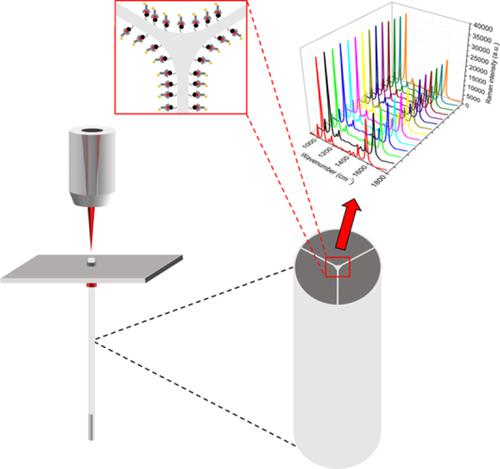当前位置:
X-MOL 学术
›
J. Biophotonics
›
论文详情
Our official English website, www.x-mol.net, welcomes your
feedback! (Note: you will need to create a separate account there.)
Development of highly reliable SERS-active photonic crystal fiber probe and its application in the detection of ovarian cancer biomarker in cyst fluid.
Journal of Biophotonics ( IF 2.0 ) Pub Date : 2019-12-26 , DOI: 10.1002/jbio.201960120 Flavien Beffara 1, 2 , Jayakumar Perumal 1 , Aniza Puteri Mahyuddin 3 , Mahesh Choolani 3 , Saif A Khan 4 , Jean-Louis Auguste 2 , Sylvain Vedraine 2 , Georges Humbert 2 , U S Dinish 1 , Malini Olivo 1
Journal of Biophotonics ( IF 2.0 ) Pub Date : 2019-12-26 , DOI: 10.1002/jbio.201960120 Flavien Beffara 1, 2 , Jayakumar Perumal 1 , Aniza Puteri Mahyuddin 3 , Mahesh Choolani 3 , Saif A Khan 4 , Jean-Louis Auguste 2 , Sylvain Vedraine 2 , Georges Humbert 2 , U S Dinish 1 , Malini Olivo 1
Affiliation

|
Conventionally Surface‐enhanced Raman spectroscopy (SERS) is realized by adsorbing analytes onto nano‐roughened planar substrate coated with noble metals (silver or gold) or their colloidal nanoparticles (NPs). Nanoscale irregularities in such substrates/NPs could lead to SERS sensors with poor reproducibility and repeatability. Herein, we demonstrate a suspended core photonic crystal fiber (PCF) based SERS sensor with extremely high reproducibility and repeatability in measurement with a relative SD of only 1.5% and 4.6%, respectively, which makes it more reliable than any existing SERS sensor platforms. In addition, our platform could improve the detection sensitivity owing to the increased interaction area between the guided light and the analyte, which is incorporated into the holes that runs along the length of the PCF. Numerical calculation established the significance of the interplay between light coupling efficiency and evanescent field distribution, which could eventually determine the sensitivity and reliability of the developed SERS active‐PCF sensor. As a proof of concept, using this sensor, we demonstrated the detection of haptoglobin, a biomarker for ovarian cancer, contained within the ovarian cyst fluid, which facilitated in differentiating the stages of cancer. We envision that with necessary refinements, this platform could potentially be translated as a next‐generation highly sensitive SERS‐active opto‐fluidic biopsy needle for the detection of biomarkers in body fluids.
中文翻译:

高度可靠的SERS活性光子晶体光纤探针的开发及其在囊液中卵巢癌生物标志物检测中的应用。
传统上,表面增强拉曼光谱(SERS)是通过将分析物吸附到涂有贵金属(银或金)或它们的胶体纳米颗粒(NPs)的纳米粗糙平面基材上来实现的。此类底物/ NP中的纳米级不规则现象可能导致SERS传感器的重现性和可重复性差。本文中,我们演示了基于悬浮芯光子晶体光纤(PCF)的SERS传感器,其测量的可重复性和可重复性极高,相对SD分别仅为1.5%和4.6%,这使其比任何现有的SERS传感器平台都更加可靠。此外,由于引导光和分析物之间的相互作用区域增加,我们的平台可以提高检测灵敏度,该相互作用区域并入了沿PCF长度延伸的孔中。数值计算确定了光耦合效率和e逝场分布之间相互作用的重要性,这最终可以确定已开发的SERS有源PCF传感器的灵敏度和可靠性。作为概念的证明,我们使用该传感器证明了对卵巢囊肿液中包含的卵巢癌生物标记物触珠蛋白的检测,这有助于区分癌症的阶段。我们设想,通过必要的改进,该平台有可能被翻译成用于检测体液中生物标志物的下一代高灵敏度SERS活性光流体活检针。最终可以确定已开发的SERS有源PCF传感器的灵敏度和可靠性。作为概念的证明,使用此传感器,我们证明了检测卵巢囊肿液中所含的触珠蛋白是卵巢癌的一种生物标志物,有助于区分癌症的阶段。我们设想,通过必要的改进,该平台有可能被翻译成用于检测体液中生物标志物的下一代高灵敏度SERS活性光流体活检针。最终可以确定已开发的SERS有源PCF传感器的灵敏度和可靠性。作为概念的证明,使用此传感器,我们证明了检测卵巢囊肿液中所含的触珠蛋白是卵巢癌的一种生物标志物,有助于区分癌症的阶段。我们设想,通过必要的改进,该平台有可能被翻译成用于检测体液中生物标志物的下一代高灵敏度SERS活性光流体活检针。
更新日期:2019-12-26

中文翻译:

高度可靠的SERS活性光子晶体光纤探针的开发及其在囊液中卵巢癌生物标志物检测中的应用。
传统上,表面增强拉曼光谱(SERS)是通过将分析物吸附到涂有贵金属(银或金)或它们的胶体纳米颗粒(NPs)的纳米粗糙平面基材上来实现的。此类底物/ NP中的纳米级不规则现象可能导致SERS传感器的重现性和可重复性差。本文中,我们演示了基于悬浮芯光子晶体光纤(PCF)的SERS传感器,其测量的可重复性和可重复性极高,相对SD分别仅为1.5%和4.6%,这使其比任何现有的SERS传感器平台都更加可靠。此外,由于引导光和分析物之间的相互作用区域增加,我们的平台可以提高检测灵敏度,该相互作用区域并入了沿PCF长度延伸的孔中。数值计算确定了光耦合效率和e逝场分布之间相互作用的重要性,这最终可以确定已开发的SERS有源PCF传感器的灵敏度和可靠性。作为概念的证明,我们使用该传感器证明了对卵巢囊肿液中包含的卵巢癌生物标记物触珠蛋白的检测,这有助于区分癌症的阶段。我们设想,通过必要的改进,该平台有可能被翻译成用于检测体液中生物标志物的下一代高灵敏度SERS活性光流体活检针。最终可以确定已开发的SERS有源PCF传感器的灵敏度和可靠性。作为概念的证明,使用此传感器,我们证明了检测卵巢囊肿液中所含的触珠蛋白是卵巢癌的一种生物标志物,有助于区分癌症的阶段。我们设想,通过必要的改进,该平台有可能被翻译成用于检测体液中生物标志物的下一代高灵敏度SERS活性光流体活检针。最终可以确定已开发的SERS有源PCF传感器的灵敏度和可靠性。作为概念的证明,使用此传感器,我们证明了检测卵巢囊肿液中所含的触珠蛋白是卵巢癌的一种生物标志物,有助于区分癌症的阶段。我们设想,通过必要的改进,该平台有可能被翻译成用于检测体液中生物标志物的下一代高灵敏度SERS活性光流体活检针。












































 京公网安备 11010802027423号
京公网安备 11010802027423号